中英对照初中英语教案模板(2015版,含全英内容)
英语初一教案全英文

英语初一教案全英文【篇一:外研版新版初一英语下全册教案-英文版】第一模块: (5课时)module 1 lost and foundunit 1 whose bag is this?i. 课时 1课时ii. type of lesson: listening and speakingiii. teaching aims:i. knowledge aim: 学习和掌握名词性物主代词ii. ability aim: 能听懂有关失物招领的对话并表演在失物招领处发生的事情iii. emotion aim: 学会与他人交流时言行举止大方得体,对他人提供的帮助表示感谢iv. teaching important and difficult pointsi. teaching important points: make the students understand and usethe dialogueii. teaching difficult points: make sure the students can use thedialoguev. teaching aids: multi-media tape , recordervi. teaching procedurestep 1 lead-inuse a pen that was lost last term and ask whose pen is this? purpose: make the students interested in the topicstep 2 learning the dialoguei. learn the new words1activity1 match the words from the box with the pictures同步练习:step 3 pronunciationstep 4 sum up and exercisestep 5: homeworkvii. blackboard writingviii. 反思unit 2 are they yours?i. 课时 2课时(课文讲解练习)ii. type of lesson: reading and writingiii. teaching aims:iv. knowledge aim: 学习和掌握新单词v. ability aim: 能读懂有关失物招领的短文,能写出一则招领启事vi. emotion aim: 学会与他人交流时言行举止大方得体,对他人提供的帮助表示感谢iv. teaching important and difficult pointsi. teaching important points: make the students understand thepassageii. teaching difficult points: make sure the students can find someuseful information from the passage and write a lost and found note.2v. teaching aids: multi-media tape , recordervi. teaching procedurestep 1 pre-readinglearn the new words and show the students a lost and found note,lead in the passage.step 2 while-readingactivity 1: listen and read the passage.activity 2: read the passage and answer the questions.activity3: translate and explain the language pointsactivity 4: complete the passage with the correct form of the wordsand expressions from the box. (activity3 on p5)step 3 post-readingwriting (activity 4 on p5)step 4 sum up and exercisestep 5: homeworkvii. blackboard writingviii. 反思unit 3 language in usei. 课时 2课时(课本练习练习册)ii. type of lesson: grammariii. teaching aims:vii. knowledge aim: 名词性物主代词和形容词性物主代词的用法viii. ability aim: 能利用名词性物主代词和形容词性物主代词3解决一些问题ix. emotion aim: 学会与他人交流时言行举止大方得体,对他人提供的帮助表示感谢iv. teaching important and difficult pointsi. teaching important points: make the students solve somequestionsii. teaching difficult points: make sure the students do the exercisesv. teaching aids: multi-media tape , recordervi. teaching procedurestep 1: activity 1: work in pairs. ask and answer questions.the teacher prepare some school things, ask every pair to choose aschool thing, show the students a model, like this:--whose bag is this? is it yours?--no, it’s not mine. it’s his.give the students two minutes to make the dialogue, then present inthe class.activity 2: complete the sentences with the correct form of the words from the box.give the students three minutes to finish it themselves, then checkthe answers together.step 3: match the words from box a with the words from box b. this activity is very easy, so the students can do it together.step 4: around the world---the internet lost and found4ask the students read by themselves, then translate one by one, theteacher explain the language points.step 5: activity 4: work in pairs.the teacher prepares some things such as camera, crayons, football,gloves, mobile phone, wallet, watch and so on.student a: think of three or four things he/she has lost orhe/she canchoose from the box. describe them.student b: think of five or six things you have in your lost and found office or you can choose from the box. describe them.then ask and answer questions.student a: ask student b if they’ve got the things you have lost. answer questions about details.student b: answer questions about the things student a has lost.ask questions about details.give the students five minutes to prepare, then act out in the class.step 6: homeworkvii. blackboard writingunit 3 language in useviii. 反思5【篇二:全英文英语教案】teaching plan姓名学号班级科目:指导老师lesson 3 living abroadⅠ.background information:1. student: 45 senior high school students, grade 22. class duration: 45 minsⅡ.teaching aims:by the end of the lesson, students will be able to1. use the new words and phrases to express themselves;2. know the functions of present participle and make sentences with the grammar;3. find some cultural differences between chinese and american.Ⅲ.teaching contents:1. vocabulary and phrases that help to express culturaldifferences, such as embarrassed, embarrassing, exchange, host, hospitable, appetite, modest, stare at, have a difficult time doing sth. insist / keep on doing sth. notice / hear / see sb. doing sth.2. functions of present participle:⑴ hear sb. doing sth. (object complement)⑵ an embarrassing experience (attribute)⑶ what he did is amazing. (predicate)⑷ i went back to the room closing the door. (adverbial)3. some cultural differences between chinese and american in three different situations.Ⅳ.teaching aids: ppt, pictures, paper.Ⅴ.teaching procedures:step 1. lead- int: good morning, everyone!ss: good morning, teacher!step 2. learn the new words and phrasest: before the text, let us learn the new words. oh, the first two words are embarrassing. do not worry! now, we only need to recognize them. “embarrassed” means feeling shy and stupid, and we say sb. feel embarrassed. “embarrassing” refers to making sb. feel shy and stupid, and we say sth. is embarrassing. the subject is different, and you can compare them with “interested” and “interesting”. understand?ss: yes!t: ok! next, the word “change” means “交换”, while “exchange” refers to“交换或交流”. for example, “cultural exchange” means — (ask students to translate it.)ss: 文化交流.t: yes! then, when foreign friends come to china, we chinese, as the host or hostess, should be hospitable. (point at the ppt and say “friendly and generous”.) appetite---when the host or hostess is hospitable, the guest may feel delighted and have a good appetite (point at the ppt and say “desire for food”.) now, the last two words. (point at the ppt.) most chinese are modest. (point at the ppt and say “talking little about one’s own ability and achievement) “stare at” means looking at for a long time without moving. read after me —“embarrassed”.ss: embarrassed.(read after me: embarrassing, exchange, host, hospitable, appetite, modest, stare at)t: do you know how to use the new words in phrases? let us learn them together. (next ppt.) no strange words in the phrases, so we start directly. xxx, the meaning of the first one, please.student a: 度过一段困难时期t: yes, sit down please. this phrase is similar to “have difficulty doing sth.” xxx, the second one, please.student b: 有一次尴尬经历t: right! sit down, please. “look embarrassed” means “看起来尴尬”. and what about the fourth one?ss: 胃口好,有食欲.t: good! then, both “insist on” and “keep on” mean “继续”. the last one! “notice / hear / see + sb. + doing sth.” means “注意到/听到/看到+某人+正在做某事”. (show the sentences.) xxx, could you translate the sentences into chinese for us? student c: 我听见她正在唱歌和我听到过她唱歌。
初中英语教案设计模板全英文版(共8篇)
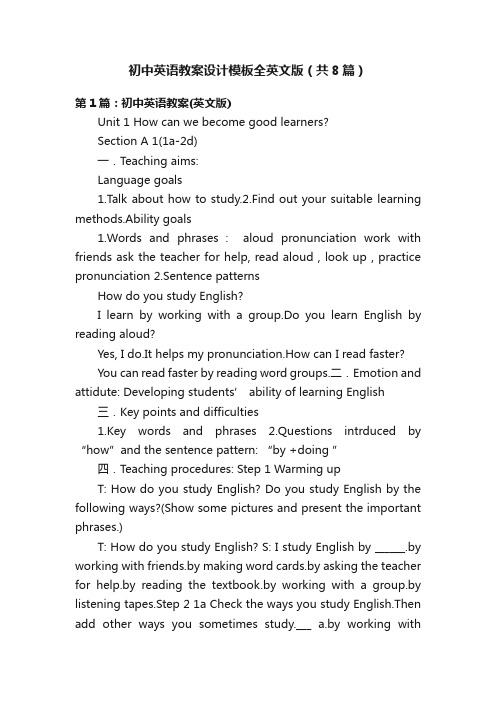
初中英语教案设计模板全英文版(共8篇)第1篇:初中英语教案(英文版)Unit 1 How can we become good learners?Section A 1(1a-2d)一.Teaching aims:Language goals1.Talk about how to study.2.Find out your suitable learning methods.Ability goals1.Words and phrases:aloud pronunciation work with friends ask the teacher for help, read aloud , look up , practice pronunciation2.Sentence patternsHow do you study English?I learn by working with a group.Do you learn English by reading aloud?Yes, I do.It helps my pronunciation.How can I read faster?You can read faster by reading word groups.二.Emotion and attidute: Developing students’ ability of learning English 三.Key points and difficulties1.Key words and phrases2.Questions intrduced by “how”and the sentence pattern: “by +doing ”四.Teaching procedures: Step 1 Warming upT: How do you study English? Do you study English by the following ways?(Show some pictures and present the important phrases.)T: How do you study English? S: I study English by ______.by working with friends.by making word cards.by asking the teacher for help.by reading the textbook.by working with a group.by listening tapes.Step 2 1a Check the ways you study English.Then add other ways you sometimes study.___ a.by working withfriends.___ b.by making word card.___ c.by reading the textbook.___ d.by listening to tapes ___ e.by asking the teacher for help.…Step 3 Listening1)Listen.How do these students study for a test? Write letters from 1a above.2)Check the answers: b(Meiping);e(Peter);d(Tony)Step 4 Gue Show some pictures.Gue: How does he/she study English? He/She studies English by…How do they study English? They study English by… Step 5 Pairwork1c Make conversations about how you study for a test.A: How do you study for a test?B: I study by working with a group.A: How do you study for a test?B: I study by… Step 6 Listening2a Listen and check the questions you hear.1 ____ Does anyone learn English by watching videos? 2 ____ Do you have conversations with friends in English? 3 ____ What about listening to tapes? 4 ____ What about reading aloud to practice pronunciation? 5 ____ Have you ever studied with a group?Answers: 1, 2, 4, 5 2b Listen again.Match each answer below with a question above.a.Yes, I have.I’ve learned a lot that way.b.Oh, yes.It really improves my speaking skills.c.I do that sometimes.I think it helps.d.No.It’s too hard to understand spoken English.Answers: d, b, c, a Step 7 Pairwork 1.2c Make conversations using the information in 2a and 2bA: Have you ever studied with a group?B: Yes, I have.I’ve learned a lot that way.Show some pictures.1)A: Do you learn English by watching movies?B: Yes, it’s a very interesting way.C: No, it’s too hard tounderstand spoken English.2)A: What about writing letters to a pen pal in America?B: Yes, it helps to improve my writing skills and know a lot aboutAmerica.3)A: Do you have conversations with friends in English?B: Of course, we can talk about plenty of things like school, pets,movies, and our parents.Step 8 SummaryHow do you study English?1.by working with friends2.by watching English movies.3.by making word cards.4.by reading the textbook.5.by listening to tapes.6.by asking the teacher for help.7.by reading aloud.Step9 Homework How do you study English? What about physics and Chinese? Make a list.第2篇:初中英语说课稿获奖全英文版Oral Presentation of Leon Plan for Unit 12 My favorite subject is science Go for it Grade 7(注:本说课稿根据“2007年首届全国中学英语教师教学基本功大赛暨教学观摩研讨会(初中)”)[Presenting the 1st PPT about the introduction.] Well, good afternoon ladies and gentlemen, I am very happy to meet you all here.Today,I am going to present Unit 12 Writing.Well, please look at the teaching material together.Well, this is a letter in the book.Students are required to read it through, have a look at it, try to write a letter to Zhao Jie, a boy who doesn’t like any subjects at all.[Presenting the 2nd PPT about the given letter.] Well, I think my teaching aims should include the proper form of English letter, and second, how to write a letter in an idiomatic way.[Presenting the 3rd PPT about the teaching aims.]Well, to achieve these goals, I am going to arrange myteaching step by step [Presenting the 4th PPT about the teaching procedures].Well, these are the steps, since so many, let me make it simple, actually, they are words, sentences and paragraphs.As we know that articles consist of words and sentences.So first, I would like to talk about the words.That is also the first step---revision.Well, you know, students have learned the names of the subjects in the former leons.So, I am going to review the words by playing games with them.Here comes the first game: who can write more? [Presenting the 5th PPT about the 1st game]I am going to divide the students into two groups, for example boys and girls.They are given two minutes to rush to the blackboard and write down the subjects they know.The group which can write more will be the winner.Imagine how excited the students are, and at the same time, they are also reviewing the words.Well, what’s more, you may have noticed these two subjects, Physics and Chemistry.[Presenting the 6th PPT about the result of the game] Actually, these two subjects are not in this book.So, in this way, we can know that some students are showing us how much they know and all the students can also enlarge their vocabulary at the same time.Well, after words, I would like to turn to sentences.Here comes the second game, who can make it longer? [Presenting the 7th PPT about the 2nd game] I am going to give students a word, for example subject.Which students can make it longer? Well, you please.Favorite subject.Good.A phrase appears.Longer? You please.My favorite subject is English.Well, a sentence appears.Even longer? My favorite subject is English, I like it very much, it is so interesting.[Presenting the 8th PPT about the answers of the game]Well, you can see students are constructing words into sentences step by step.Well, this is the revision part.After that, it is time to read.From now, I am going toshow students the given material so soon.Actually, instead, I am going to show them those separated pieces.They should put them into the correct order[Presenting the 9th PPT about the reordering task].You know before the leon, I divided the whole letter into these four parts, why do I bother to do this? Well, you can see, in this way, students can put more attention to how to begin and how to end a letter.Then, they have a time, can have a chance to read through the whole article[Presenting the 10 th PPT about the reading material].Well, at the same time, they should also pick out those well used words and sentences, and share them with the whole cla.Then, they have a discuion “what information can we use? [Presenting the 11th PPT about the discuion task]Why talking about subjects? Of course, it is easy for them to find these information like these three ones(time & day, teacher, reason), because they are in the letter.But what else? Students need to think about that.Well, why? As we know it is easy to copy, but difficult to create.Sometimes, the given material gives us a good example, but sometimes, they may also limit students’ ideas.So they need to go further.As some teachers may prefer to offer the answers directly to the students.But I am not.I think teaching students how to learn is much more important than just teaching knowledge.So students should think about that by themselves.Well, this part is also a brainstorm to them.Till now, they have known so much.Since that, they should be given a chance to put wha t they’ve known into practice.So I prepare two practices[Presenting the 12th PPT about the 2 practices].Practice number one, students have a Free Talk about their favorite subjects, if they can expre themselves fluently and naturally, they won’t have much difficulty in writing them down.Well, second practice will be the real writing.They aregiven eight minutes to write a letter to Zhao Jie[Presenting the 13th PPT about the beginning of the letter].Well, when they finish writing, six students get into a group, they exchange their letters and try to correct mistakes.Why they should do that? Well, teachers may have noticed that not many students have the habit of rewriting and correcting mistakes when they finish writing, and I want them to realize this is also very important.Ok, after that, each group chooses two representatives, the best one and the one who has made great progre.Which two? I think not only those advanced students but also the le advanced students should be given a chance to show how good they are.Well, for example, yes, after that, some representative come to the front and show their letters to the whole cla, but you can think it is a projector like this.This is a student’s letter and when all students finish writing it, they are welcomed to give comments.It is so-so, good or great.So which one? Can you find any beautifull sentences here? They are welcomed to give their ideas.Well, here comes the last part[Presenting the 14th PPT about the homework].Last part will be the homework.They can either write me an email or have a talk with some one or write an article about his or her favorite ********.I think both of these are highly connected with our daily life.So, students must be very interested.Ok, so that is all.Thank you very much!(答辩问答)Questions:Anyhow, I appreciate your teaching, and allow me to say so.My question is “ how do you check the achievements of the homework you send to your pupils?Answer:Well, about this question, I think, first, still the group work.They should exchange their letters and each group should also choose two representatives and hand in the letters or the articles they have written to me, and I correct them bymyself.And then, put all these representatives’ works on the wall and show them to the whole cla.By this way.Thank you!第3篇:全英初中英语教案鲁人办发[2008]78号关于做好2008年省内高校特困家庭毕业生求职补贴发放工作的通知各高等学校:按照山东省人民政府办公厅《关于做好特困家庭高校毕业生就业工作的通知》(鲁政办发[2008]21号)要求,现就做好2008年省内高校特困家庭毕业生求职补贴发放工作有关事项通知如下:一、发放范围求职补贴发放范围为符合城乡低保、零就业家庭、农村贫困家庭等特殊情况,就业有困难需要帮助的2008年省内高校山东生源应届毕业生(以下简称特困生)。
初中英语全英教案模板

Lesson Title: [Subject of the Lesson]Grade Level: [Grade]Subject: EnglishDuration: [Duration in minutes]Objective: [State the main objective(s) of the lesson]Materials Needed:- Textbook- Workbook- Whiteboard and markers- Projector or multimedia tools (optional)- Handouts or worksheets- Flashcards (optional)- Audio/Video materials (optional)Preparation:1. Familiarize yourself with the lesson content and vocabulary.2. Prepare any necessary handouts or worksheets.3. Set up the classroom environment for active learning.4. Have all materials ready and accessible.Warm-up (5 minutes):1. Greet students in English and ask them how they are doing.2. Conduct a quick review of previously learned vocabulary or grammar concepts using a simple game or activity.3. Engage students in a short discussion about the theme of the lesson.Introduction (5 minutes):1. Introduce the lesson topic using a visual aid, such as a picture or a short video clip.2. Use simple English to explain the purpose of the lesson and any key vocabulary.3. Pose a thought-provoking question related to the topic to stimulate discussion.Presentation (10-15 minutes):1. Use the textbook and any additional materials to present new vocabulary and grammar structures.2. Use a variety of teaching methods, such as:- Demonstrating the correct pronunciation and intonation.- Providing examples in context.- Using interactive whiteboard activities or multimedia tools to illustrate concepts.3. Encourage students to participate by asking questions and involving them in the learning process.Practice (15-20 minutes):1. Divide the class into small groups or pairs.2. Assign a task that requires students to practice the new vocabulary and grammar. Examples include:- Role-playing a dialogue.- Completing a fill-in-the-blanks exercise.- Creating a simple story or script using the new vocabulary.3. Monitor student progress and provide feedback as needed.Activity (15-20 minutes):1. Plan an activity that allows students to apply what they have learned in a real-life context. Examples include:- A group project where students create a poster or presentation.- A game that reinforces vocabulary or grammar.- A debate or discussion on a related topic.2. Ensure that the activity is inclusive and allows for different learning styles.Conclusion (5 minutes):1. Summarize the main points of the lesson using English.2. Review any new vocabulary or grammar structures.3. Assign homework that reinforces the lesson content, such as:- Completing workbook exercises.- Writing a short essay or story.- Watching a video clip or reading an article related to the topic.Assessment:1. Evaluate student understanding through observations during activities and discussions.2. Collect and review homework assignments to assess student progress.3. Provide individual or group feedback on student performance.Reflection:1. Reflect on the effectiveness of the lesson by considering:- Student engagement and participation.- The clarity of the instructions and explanations.- The appropriateness of the activities and resources.2. Make notes for future reference to improve teaching methods and lesson planning.---This template provides a structured outline for a full English lesson in a初中 classroom. It is important to adapt the content and activities to suit the specific needs and abilities of the students, as well as to maintain a dynamic and interactive learning environment.。
初中英语教案设计模板全英文
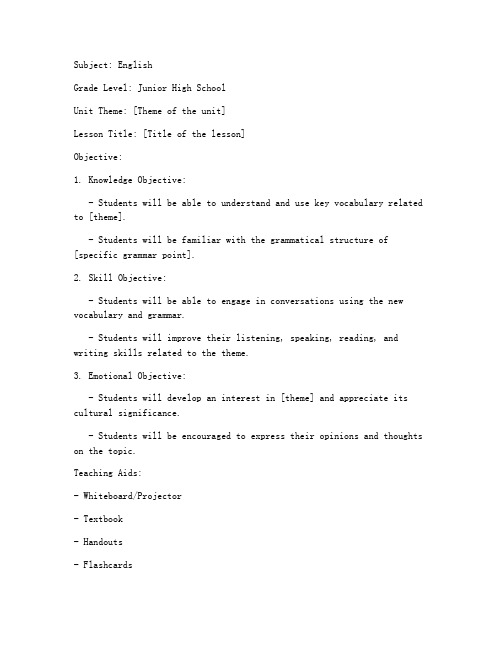
Subject: EnglishGrade Level: Junior High SchoolUnit Theme: [Theme of the unit]Lesson Title: [Title of the lesson]Objective:1. Knowledge Objective:- Students will be able to understand and use key vocabulary related to [theme].- Students will be familiar with the grammatical structure of [specific grammar point].2. Skill Objective:- Students will be able to engage in conversations using the new vocabulary and grammar.- Students will improve their listening, speaking, reading, and writing skills related to the theme.3. Emotional Objective:- Students will develop an interest in [theme] and appreciate its cultural significance.- Students will be encouraged to express their opinions and thoughts on the topic.Teaching Aids:- Whiteboard/Projector- Textbook- Handouts- Flashcards- Audio/Video materials- Computer and internet access (if needed)Preparation:1. Familiarize yourself with the textbook and the lesson objectives.2. Prepare handouts and flashcards with key vocabulary and phrases.3. Create or find appropriate audio/visual materials to support the lesson.4. Plan for different learning styles by incorporating various teaching methods.Teaching Procedures:1. Warm-up (5 minutes)- Activity: Quick revision of previous lessons or vocabulary through a game or a quick quiz.- Purpose: To activate prior knowledge and get students engaged in the lesson.2. Introduction (10 minutes)- Activity: Briefly introduce the theme and the main content of the lesson.- Purpose: To set the context and create interest in the topic.3. Vocabulary Teaching (15 minutes)- Activity: Introduce new vocabulary through pictures, realia, or gestures.- Teaching Method: Use TPR (Total Physical Response) or Mnemonic techniques to help students remember the words.- Practice: Have students match words with their meanings or use them in sentences.4. Grammar Point (15 minutes)- Activity: Explain the grammatical structure clearly and provide examples.- Teaching Method: Use visual aids or demonstrations to illustrate the concept.- Practice: Have students complete exercises or activities thatreinforce the grammar point.5. Reading Comprehension (15 minutes)- Activity: Read a passage or a story related to the theme.- Teaching Method: Use skimming and scanning techniques to identify main ideas and details.- Practice: Ask comprehension questions and discuss the content.6. Listening Comprehension (10 minutes)- Activity: Play an audio clip or a video related to the theme.- Teaching Method: Have students listen for specific information or follow instructions.- Practice: Discuss the content and answer questions based on the listening material.7. Speaking Practice (15 minutes)- Activity: Conduct role-plays, group discussions, or presentations.- Teaching Method: Provide opportunities for students to practice speaking in a supportive environment.- Practice: Encourage students to use new vocabulary and grammar structures.8. Writing Practice (10 minutes)- Activity: Have students write a short paragraph or a summary of the lesson.- Teaching Method: Provide a writing frame or guidelines to help students organize their thoughts.- Practice: Circulate around the classroom to provide feedback and assistance.9. Wrap-up (5 minutes)- Activity: Review the main points of the lesson and vocabulary.- Purpose: To reinforce learning and provide closure to the lesson.Homework:- Assign relevant exercises from the textbook or additional activities to reinforce learning.Assessment:- Evaluate student。
中英对照初中英语教案模板
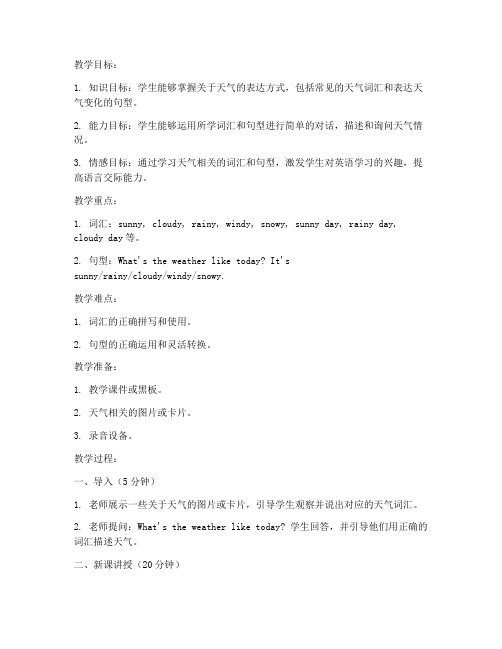
教学目标:1. 知识目标:学生能够掌握关于天气的表达方式,包括常见的天气词汇和表达天气变化的句型。
2. 能力目标:学生能够运用所学词汇和句型进行简单的对话,描述和询问天气情况。
3. 情感目标:通过学习天气相关的词汇和句型,激发学生对英语学习的兴趣,提高语言交际能力。
教学重点:1. 词汇:sunny, cloudy, rainy, windy, snowy, sunny day, rainy day, cloudy day等。
2. 句型:What's the weather like today? It'ssunny/rainy/cloudy/windy/snowy.教学难点:1. 词汇的正确拼写和使用。
2. 句型的正确运用和灵活转换。
教学准备:1. 教学课件或黑板。
2. 天气相关的图片或卡片。
3. 录音设备。
教学过程:一、导入(5分钟)1. 老师展示一些关于天气的图片或卡片,引导学生观察并说出对应的天气词汇。
2. 老师提问:What's the weather like today? 学生回答,并引导他们用正确的词汇描述天气。
二、新课讲授(20分钟)1. 老师通过课件或黑板,介绍天气相关的基本词汇,如sunny, cloudy, rainy, windy, snowy等。
2. 老师讲解并示范句型:What's the weather like today? It'ssunny/rainy/cloudy/windy/snowy.3. 学生跟读并模仿,老师纠正发音和语调。
三、巩固练习(15分钟)1. 老师组织学生进行小组活动,让学生用所学词汇和句型描述不同天气情况下的活动。
2. 学生互相提问,如:What's the weather like today? What will you do? 等。
3. 老师巡回指导,纠正学生的发音和语法错误。
四、课堂小结(5分钟)1. 老师带领学生回顾本节课所学内容,强调重点词汇和句型。
初中英汉双译课程教案模板
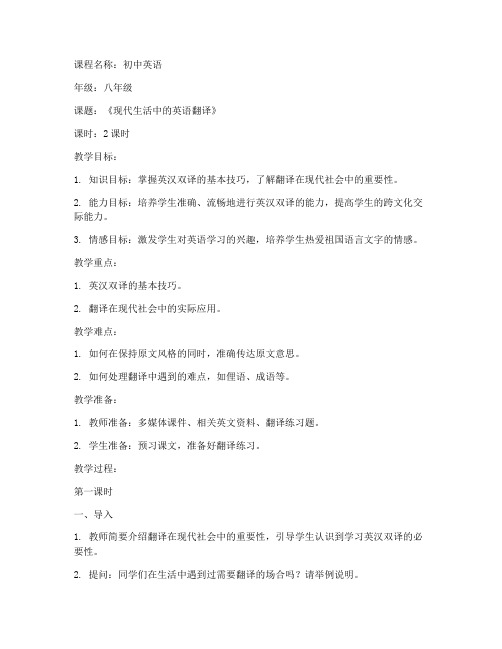
课程名称:初中英语年级:八年级课题:《现代生活中的英语翻译》课时:2课时教学目标:1. 知识目标:掌握英汉双译的基本技巧,了解翻译在现代社会中的重要性。
2. 能力目标:培养学生准确、流畅地进行英汉双译的能力,提高学生的跨文化交际能力。
3. 情感目标:激发学生对英语学习的兴趣,培养学生热爱祖国语言文字的情感。
教学重点:1. 英汉双译的基本技巧。
2. 翻译在现代社会中的实际应用。
教学难点:1. 如何在保持原文风格的同时,准确传达原文意思。
2. 如何处理翻译中遇到的难点,如俚语、成语等。
教学准备:1. 教师准备:多媒体课件、相关英文资料、翻译练习题。
2. 学生准备:预习课文,准备好翻译练习。
教学过程:第一课时一、导入1. 教师简要介绍翻译在现代社会中的重要性,引导学生认识到学习英汉双译的必要性。
2. 提问:同学们在生活中遇到过需要翻译的场合吗?请举例说明。
二、新课讲解1. 教师讲解英汉双译的基本技巧,如直译、意译、音译等。
2. 结合实例,讲解如何处理翻译中的难点,如俚语、成语等。
3. 强调翻译时应注意的几个问题:忠实原文、保持风格、准确传达。
三、课堂练习1. 学生进行翻译练习,教师巡视指导。
2. 学生展示翻译成果,教师点评。
四、总结1. 教师总结本节课所学内容,强调英汉双译的重要性。
2. 学生分享学习心得,教师给予鼓励。
第二课时一、复习1. 复习上节课所学内容,检查学生对英汉双译基本技巧的掌握情况。
2. 学生举例说明翻译在现代社会中的实际应用。
二、拓展练习1. 教师提供一段英文材料,要求学生进行英汉双译。
2. 学生分组进行翻译,教师巡视指导。
三、课堂展示1. 学生展示翻译成果,教师点评。
2. 学生分享翻译心得,教师给予鼓励。
四、总结1. 教师总结本节课所学内容,强调翻译在现代社会中的重要性。
2. 学生分享学习心得,教师给予鼓励。
教学反思:1. 本节课是否达到了教学目标?2. 学生对英汉双译的兴趣是否有所提高?3. 如何改进教学方法,提高学生的翻译能力?教学评价:1. 学生对英汉双译的掌握程度。
中英对照初中英语教案模板(2015版-含全英内容)

Additional new words: supper, whoballet.
Homework
(作业布置)
1.Reading on Page 4and page90
2.Buying a new postcard FOR next lesson.
Board design
(板书设计)
Unit 2 They’re going to the opera.
Key points:watching a ballet.
put on, at this moment, leave work,Difficult sentence:
at home, get dressed, look at,Some are going to the opera orwatching a ballet.
Post-task activity: Group work
Present their a
Text explanation
Discuss the sentences in the text, and try to get familiar with the words and phrases.
Emphasis on teaching
(教学重点)
Reading ability: read for details.
Vocabulary: thing,restaurant,wash,start,hot dog.
Key points: put on, at this moment, leave work,at home, get dressed, look at,see you soon
初中双语授课教案模板
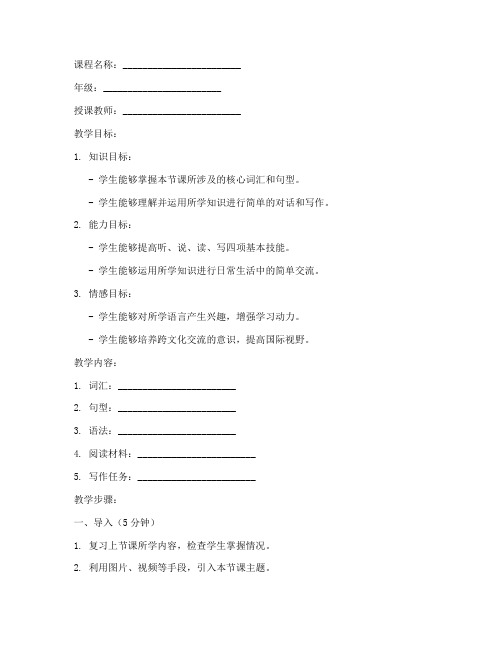
课程名称:________________________年级:________________________授课教师:________________________教学目标:1. 知识目标:- 学生能够掌握本节课所涉及的核心词汇和句型。
- 学生能够理解并运用所学知识进行简单的对话和写作。
2. 能力目标:- 学生能够提高听、说、读、写四项基本技能。
- 学生能够运用所学知识进行日常生活中的简单交流。
3. 情感目标:- 学生能够对所学语言产生兴趣,增强学习动力。
- 学生能够培养跨文化交流的意识,提高国际视野。
教学内容:1. 词汇:________________________2. 句型:________________________3. 语法:________________________4. 阅读材料:________________________5. 写作任务:________________________教学步骤:一、导入(5分钟)1. 复习上节课所学内容,检查学生掌握情况。
2. 利用图片、视频等手段,引入本节课主题。
二、词汇学习(10分钟)1. 教师展示本节课的核心词汇,并进行讲解。
2. 学生跟读并拼写词汇。
3. 进行词汇游戏,如“猜单词”、“单词接龙”等,巩固记忆。
三、句型学习(10分钟)1. 教师展示本节课的核心句型,并进行讲解。
2. 学生跟读并模仿句型。
3. 进行句型练习,如角色扮演、小组讨论等。
四、语法讲解(10分钟)1. 教师讲解本节课的语法知识点,并进行例句展示。
2. 学生跟随教师一起练习语法,巩固所学知识。
五、阅读材料(15分钟)1. 教师朗读阅读材料,学生跟读并理解大意。
2. 学生回答教师提出的问题,检查对阅读材料的理解程度。
3. 学生进行阅读材料复述,提高阅读能力。
六、写作任务(15分钟)1. 教师讲解写作任务要求,并展示例文。
2. 学生进行写作练习,教师巡回指导。
- 1、下载文档前请自行甄别文档内容的完整性,平台不提供额外的编辑、内容补充、找答案等附加服务。
- 2、"仅部分预览"的文档,不可在线预览部分如存在完整性等问题,可反馈申请退款(可完整预览的文档不适用该条件!)。
- 3、如文档侵犯您的权益,请联系客服反馈,我们会尽快为您处理(人工客服工作时间:9:00-18:30)。
(板书设计)
Unit 2 They’re going to the opera.
Key points:watching a ballet.
put on, at this moment, leave work,Difficult sentence:
at home, get dressed, look at,Some are going to the opera orwatching a ballet.
Aims of teaching
(教学目标)
1.To get information from reading material about what people are doing in different places.
2.To get to know how to write a postcard.
(教学内容)
Unit 2 They’re going to the opera.
Analysis of the teaching material
(教材分析)
The reading passage has so much information, and there are quite a few new words in it. This will help to improve students’ reading skill.
Vocabulary and sentence structure
1.Words guessing
2.Say what the people in the photos are doing.
Students are supposed to match the new words with picture in Part 1 on Page 4, and to be able to read the new words, and then to know the meanings of the words.
3.Then ask students to finish part3 on page5.
Pre-task activity: Pair work
Read the title on Page 4. Then discuss in pairs what the text will talk about. After discussion, some students should be asked to tell the whole class about their guessing.
Practice
(情景操练/巩固练习)
1.Ask the students to read the title on Page 4&Part 2 on Page 5, then guess what will the text talk about.
2.After that, ask st8
udents to read and find out information.
2.The others talk about what they are doing.
Some students would be asked to do some actions.
The others talk about what they are doing.
Presentation
(讲授新课)
Teaching Tool
(教具)
1.PPTplayer & mantle
2. Cards
(设计思路)
Encourage the students
1. To predict what the text will be about by reading the title
by askingthe students to read for details.
2. Tofind out how to write a postcard by reading the post card.
see you soon=Some are going to see an operaor watch a
Additional new words: supper, whoballet.
Homework
(作业布置)
1.Reading on Page 4and page90
2.Buying a new postcard FOR next lesson.
Emphasis on teaching
(教学重ห้องสมุดไป่ตู้)
Reading ability: read for details.
Vocabulary: thing,restaurant,wash,start,hot dog.
Key points: put on, at this moment, leave work,at home, get dressed, look at,see you soon
While-task activity 1: Individual work
Read the text and underline the words.
While-task activity 2: Group work
Work in groups to complete Part 2/3 on P5.
Teachingprocess
(教学流程)
Activities of teachers
(教师活动)
Activities of students
(学生活动)
Warming up
(情景导入/导入新课)
Review what they’velearntlast lesson.
1.Ask Ss to do some actions.
Complementarywords: supper, who
Difficult sentence: Some are going to the opera orwatching a ballet.
(Some are going to see an operaor watch a ballet.)
Ideas of design
Post-task activity: Group work
Present their answers.
Summary
(情景回归/归纳总结)
Text explanation
Discuss the sentences in the text, and try to get familiar with the words and phrases.
Basic Information
(基本信息)
Teacher(教师)
Stone
Type(课型)
New
Teaching material
(教材)
EEC Grade six(Book One)
Period(课时)
1 class
Teaching Model
(教学设计)
Contents of teaching
